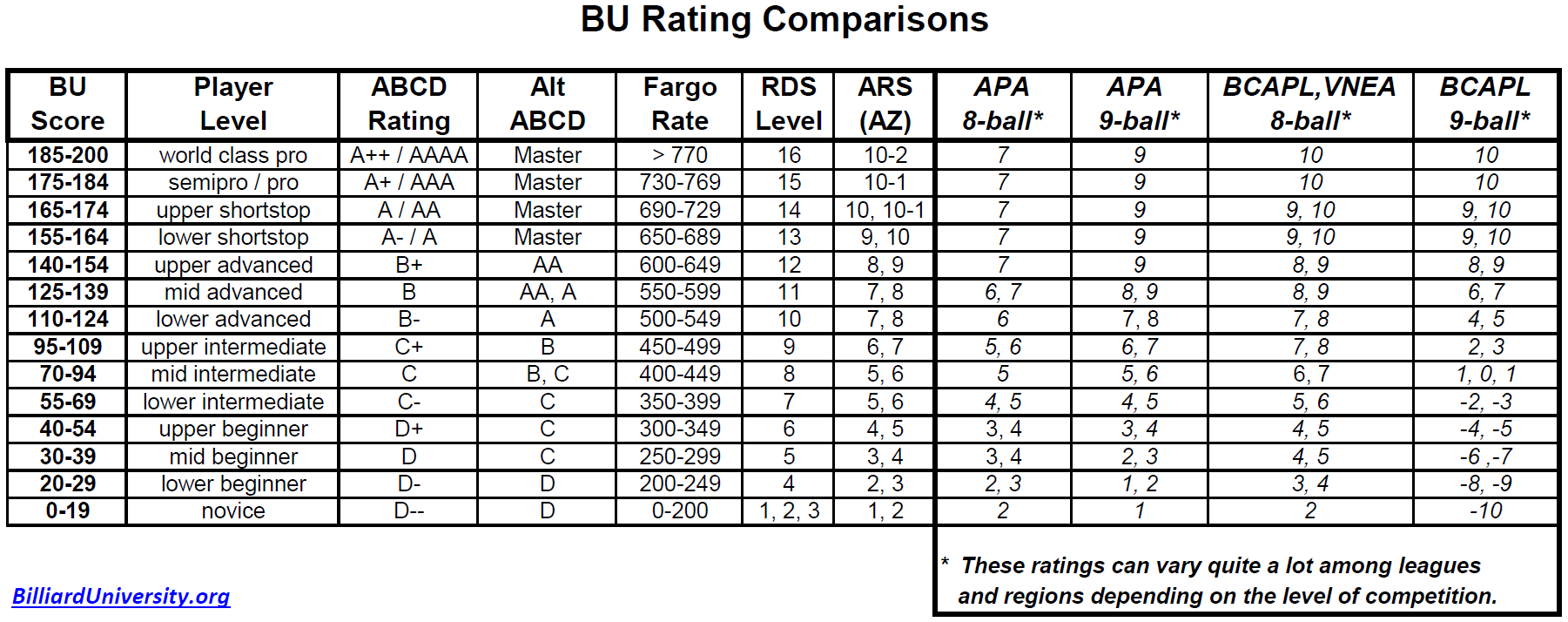How does the Runout Drill System (RDS) work?
The Runout Drill System (RDS), is a new progressive and adaptive approach to practice, teach, and learn pool. RDS consists of a set of 16 break-and-run challenges of increasing levels of difficulty. A detailed explanation can be found here:
Runout Drill System (RDS) instructions and diagrams
And here is a complete video demonstration of the progressive/adaptive version of RDS (Billiards University Exam IV):
And here is a useful 1-page RDS handout (from Shane McEwan) that concisely summarizes everything you need to know.
A fun scored variation of RDS is the RDS 100 Challenge:
In the scored version of RDS 100, you run through one rack at each level, starting with 100 points and deducting points left on the table after each miss or foul. Here are the Detailed RDS 100 Rules:
- Your video must be a continuous run with one rack at each RDS level in order.
- Start with 100 points and deduct points for balls not legally pocketed in each rack.
- Standard WPA rules apply, with CB fouls only.
- Skip Level 1, which is optional.
- You can rack the balls in any pattern on any level, assuming you satisfy the rules of any specific game being played (9-ball: 1 on the spot, 9 in the center; 8-ball: 8 in the center, solid and stripe on corners).
- If you fail to run out an 8-ball-rules rack, you get penalized only for the remaining balls in the selected group (stripes or solids) and the 8. The other group of balls has no effect on the score (unless you are required to run the remaining balls in rotation, in which case all balls count).
- In any 8-ball-rules level, if you do not legally pocket a called OB after the break, you have not earned a suit and you get no points for any balls pocketed on the break. Balls pocketed on the break do count in all other levels, even if the first post-break shot is missed.
- In any levels (or portions of levels) that say “in order,” rotation rules apply so slop counts as long as you hit the lowest numbered ball first with a legal hit. All other levels are call pocket.
- Level 14 is pure 9-ball rules. pocketing the 9 at any time (even on the break) with a legal shot is a win and you get credit for all balls.
- Balls pocketed on a rack-ending foul shot (e.g., a scratch) do not count.
- If you miscue on the break and fail to hit the balls (or don’t get a legal break), the rack is over and you loose all points for that rack.
- The challenge can be done on any table size.
- To submit an entry, just post your name, score, and video link as a comment on the RDS 100 Challenge video.
The current highest score on RDS 100 is 93:
RDS is the fourth of the Billiard University (BU) Playing Ability Exams.
Eric Simpson runs live-stream RDS 100 tournaments. Here’s an example, with a pre-tournament interview with Dr. Dave and Lil’ Chris:
If you want to enter the current or any future RDS 100 tournament, contact Eric at: Eric.simpson1989@gmail.com. The tournaments have money and T-shirt prizes. There is a $250 bonus to the first person to get a perfect score of 100 in one of the live events. A T-shirt of choice from DrDaveBilliardTshirts.com also goes to the 1st place finisher in each tournament of 8 or more players.
The BU Rating Comparison table below shows how RDS Player Levels compare to other commonly used rating and handicapping systems:

For more information, see “Player Ratings” (BD, December, 2020).
The following table shows how RDS 100 scores roughly correlate with progressive RDS playing level, per column 6 in the table above:
| RDS Level | 1,2,3 | 4 | 5 | 6 | 7 | 8 | 9 | 10 | 11 | 12 | 13 | 14 | 15 | 16 |
| RDS 100 Score | <0 | 0-9 | 10-19 | 20-29 | 30-39 | 40-49 | 50-59 | 60-69 | 70-74 | 75-79 | 80-84 | 85-89 | 90-94 | 95-100 |
The Runout Drills System (RDS) is based on concepts first presented by Bob Jewett. For more information, see:
- “The Run-30 Drill Family,” Bob Jewett, Billiards Digest, July, 2020.
- “Rack-Running Drills,” Bob Jewett, Billiards Digest, August, 2020.
- “Runout Drills System (RDS),” Dr. Dave Alciatore, Billiards Digest, October, 2020.
Dr. Dave keeps this site commercial free, with no ads. If you appreciate the free resources, please consider making a one-time or monthly donation to show your support:
